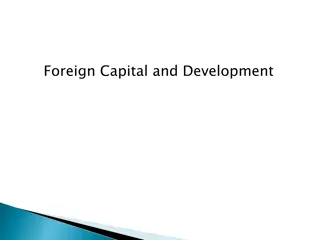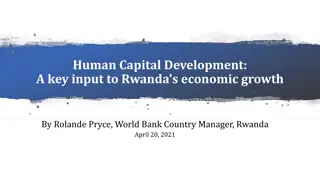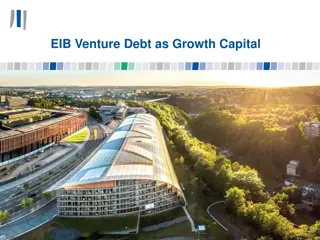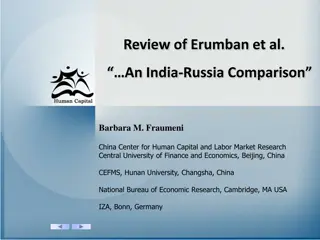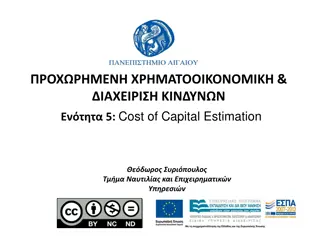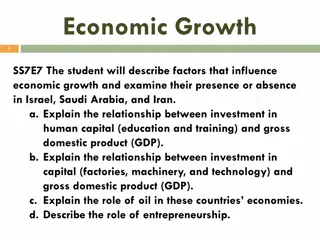The Critical Role of Human Capital in Economic Growth: A Review
Literature highlights the significance of human capital formation in driving economic growth and achieving macroeconomic objectives. Human capital accumulation enhances productivity, reduces unemployment, poverty, and inequality, underscoring the need for investments in education, health, and job training as public goods. The paper focuses on South Sudan to explore the criticality of human capital as a key driver in growth accounting and assesses the efforts of South Sudanese authorities in enhancing human capital for sustainable economic development.
Download Presentation

Please find below an Image/Link to download the presentation.
The content on the website is provided AS IS for your information and personal use only. It may not be sold, licensed, or shared on other websites without obtaining consent from the author. Download presentation by click this link. If you encounter any issues during the download, it is possible that the publisher has removed the file from their server.
E N D
Presentation Transcript
The Criticality of Human Capital in Economic Growth: A Review of Theory and Evidence James Alic Garang Economist||Policy Practitioner||Academic Founder and Managing Director, Africa Center for Financial Inclusion The National Economic Conference Organized by the Ministry of Finance and Planning Under Theme Towards a Diversified, Inclusive, and Sustainable Economic Growth Juba, South Sudan September 4-8, 2023
Presentational Contour Introduction Research Questions Literature: Theoretical and Empirical Methodology, and Data Sources Research Findings: Existing Policies, and Resource Allocation Lessons From Peers in Sub-Saharan Africa Policy Implications
Introduction Literature has demonstrated the criticality of human capital formation in fostering economic growth and achieving macroeconomic goals (Mincer, 1958; Lucas, 1977; Romer, 1988, 1989, 1998; Jibir, Abdu, & Buba, 2023). Human capital formation is defined as the act of acquiring and boosting the number of people possessing real-world skills, education, and experience. Broadly conceived, human capital formation is linked to investment in people and related advancement as well as innovation capacity for companies (Diebolt, & Hippe, 2019; Mariz-P rez, Teijeiro- lvarez, & Garc a- lvarez, 2012). Human capital improves the technical and creative skills of the labor force, with implications to augment productivity, growth, and quality of life. Consequently, available stock of human capital determines the rate of economic growth.
Introduction continued Human capital accumulation leads to productivity gains and reduces unemployment, poverty, and lessens inequality (Prasetyo, & Kistanti, 2020). These justify the need to provide subsidies for education, health, and job training, which are established as public goods. Knowledge, social, and emotional endowments constitute human capital. While different models explain the mechanics behind economic growth, they nevertheless point to the centrality of labor, capital, and technology. In this connection, human capital is subsumed in the workhorse of macroeconomic model growth.
Research Questions The paper verifies the criticality of human capital in economic growth in South Sudan and raises two related research questions: How critical is human capital as a key driver in theoretical growth accounting? To what extent have South Sudanese authorities enhanced human capital to support growth and achieve other policy objectives?
The papers Contribution to the Literature This study contributes to the ongoing debate by exploring the connection between human capital accumulation and economic growth in general and how South Sudan has been faring relative to her peers from 2015-present. The paper finds that South Sudan lags peers when it comes to actual spending on education and health. Acute challenges facing human capital formation sectors include inadequate funding, poor facilities such as dilapidated classrooms & jam-packed wards, poor incentives to professionals, ill-equipped teachers; and other limiting social norms such as early or forced marriages. This paper, therefore, validates the view that South Sudan spends less on human capital and relegates more of the latter role to development partners.
Literature: Theoretical Literature Consider two production functions (modelled as cobb- Douglas productions) Solow Growth Model Romer or Endogenous Growth Model Key Variables include: Labor (L) Capital (K) Technology (A) Population Growth (g) Depreciation (d) National Income (Y) Savings Rate (s); and Investment (I)
Solow Model It is an exogenous model, considered as the neoclassical workhorse. It simplifying assumptions, include the proportional population growth rate and a production function that takes coefficient of adjustment (a) as given. The model assumes constant returns to scale, indicating that if inputs double, then output also doubles. This leads to a focus on output per worker and capital per worker. The model links the current capital stock (K), future capital stock (K prime or K ), the rate of capital depreciation (?), and prevailing level of capital investment (represented by I) via capital accumulation equation, with K = K(1- ) + I.
Solow Model Setup Linking all variables, the production function (f) can be constructed as follows: Y =af(K, L)= aKbL1-b, where 0 < b < 1 (1) Assuming that firms are price-takers, the coefficient b represents the share of income that capital receives while 1-b is what labor receives. Dividing through by L, output per worker becomes: y = akb, noting that y = Y/L (output per worker and k = K/L (capital stock per worker) (2) Letting C denote consumption; S for savings; and I for investment, the competitive equilibrium assumption indicates that income-expenditure identity must hold, as equilibrium condition: Y = C + I (3) Analogously, the consumer s budget constraint takes the following form: Y = C + S (4) Therefore, in equilibrium, investment equals saving which is proportional to output: I = S = sY (5)
Solow Model continued The capital accumulation equation becomes: K = (1 d)K + sY (6) The capital accumulation equation in per worker over time is arrived as follows: (1 + g)k = (1 d)k + sy = (1 d)k + saf(k) = (1 d)k +sakb (7) The formulation leads to a steady state, which is a situation where the level of capital per worker does not change. The steady state is found by solving the following equation: k = k => (1 + g)k = (1 d)k + sakb (8) Therefore, collecting the like terms and solving for k, the steady state value of capital per worker and the steady state value of output per worker are stated as constants: 1 1 ? ?? ?+? K*=
Implications of the Solow Model There should be no growth in the long run assuming that countries have the same g (population growth rate), s (savings rate), and d (capital depreciation rate). The Solow model predicts conditional convergence. This explains why a poorer country must grow faster than an advanced economy. The Solow model weakness lies in its assumption of constant returns to scale, exogeneity of key inputs, and lack of agency undergirding human capital formation. These flaws lead to a search for other models, notably when one concedes that labor is a produced intermediary, which takes years of investment.
Romer or Standard Endogenous Model The standard endogenous growth model, Y = f(K, H, L, A), relates Y (per capita GDP growth) to K (capital accumulation), H (human capital), L (labor force), and A (proxy for technological progress). As Lucas (1988), Grossman and Helpman (1991), and Romer (1990) indicate, the endogenously generated human capital determines the level of output. Adopting Agezew et al. (2021), the endogenous model goes as follows: Yt= H tK t(AtLt)1- (9) Where measures human capital elasticity of aggregate production. By taking natural logarithm on both sides of this equation in #9, and rearranging, the above model can be respecified as follows: Ln Yt= ln Ht+ lnKt+1- (ln Lt+ln At) (10) Emphasizing the role of institutions, Acemoglu et al. assume that economic actors are endowed with some level of human capital (H>0), which evolves according to the following modified differential equation: t= f(t, Ht-1, St, Xt) (11)
Endogenous Model continued Where Stis the fraction of resources devoted to education, t is time, and f(t)determines how human capital changes as a function of time, the existing stock of human capital, schooling decisions, and other socioeconomic factors Xtand Ht-1refers to previous level of human capital. The evolution of schooling over time depends on the proportion of people in education and population growth. Combining equations #10 and #11, the human capital growth model can be recast thus: t= F(t, Ht-1, Yt, Kt, Lt, St, Xt) (12) Where capital. It Household decision regarding education determines the supply of human capital, while technological change determines the related demand of human capital. This means that technological change increases the demand for a skilled workforce, increasing return to education and consequently prompting human capital growth (Agezew et al., 2021). Yet, in a country boasting of a huge resource gap, human and physical capital may exhibit tradeoffs, each competing for limited funds from the state and private sector. Therefore, investing more in physical infrastructure or human capital involves tradeoffs. Ktcaptures the externality effect of physical capital accumulation on human
Empirical Literature Romer (1989), in a cross-country regression, finds that the initial level of literacy has a greater potency to predict the subsequent rate of investment, and by extension the rate of growth. Jainison, & Lau (1982) find that literacy skills foster production, with agricultural productivity positively correlated with the level of education of the farmer. Itoro Praise and George-Anokwuru (2018) assess determinants of economic growth. They use primary, secondary, and tertiary enrolments, and find positive relations between health expenditures and growth. Jibir, Abdu, and Buba (2023) find a positive correlation between productivity and investments in human capital. Taking the GMM approach and using the World Bank Panel Business Enterprise Survey data for Nigeria, their findings indicate that stocks of and investments in human capital contribute significantly to the firms productivity, including achieving organizational objectives such as profitability and firm survivability. Chevalier, Harmon, O Sullivon, and Walker (2013) use the UK Labor Force Survey data to establish the relationship between early school-leaving, parental education, and paternal income. Their OLS estimation results are revealing, indicating some effects of income, and stronger effects of maternal education relative to paternal. Hence, they find that parents income has a significant effect on educational spending, which has a positive contribution to the development of human capital.
Empirical Literature A paper by Ogbeifun, and Shobande (2022) show that human capital, the savings rate, and the openness of trade play a vital role in OECD countries' economic growth whereas inflation and life expectancy register adverse effects on growth. Their results indicate that human capital has a positive and significant relationship with economic growth. AfDB (2020) finds that average spending on education in Africa is estimated at 5 percent of national budgets. The report indicates that half of the countries in Africa continue to meet recommended spending targets, according to the United Nations. That said, the report notes spending efficiency to be worst in Africa compared to other regions (see Figure 1). In addition to closing an annual $40 billion gap in education financing, the report recommends strengthening Public Expenditure Tracking Surveys, using performance-based financing to enhance outcomes, and raising teacher quality to lessen class repetition (AfDB, 2020).
Methodology and Data Sources Sources of Data Ministry of Finance and Planning, covering the period 2015-2023. World Development Indicators, including on Human Capital Index, literacy, enrollment, spending, and select variables for South Sudan and six comparators Ethiopia, Kenya, Namibia, Rwanda, SSA Averages, and fragile situations. Research Strategy The paper reviews the literature, identifies two production functions to anchor its approach, and discusses findings. Therefore, the desk review is regarded as appropriate in the absence of empirical estimation.
Finding 1: South Sudan Policy Priorities Emphasize Human Capital Formation National Development Plan (2011-2013) Revised National Development Strategy (2021 2024): "Consolidate Peace, Stabilize the Economy, South Sudan s Interim Constitution 2011 indicates the need for the government at all levels to promote public health and education declaring them as rights. Article 2.9, Sub- article 1 emphasizes: Education is a right for every citizen and all levels of government shall provide access to education without discrimination as to religion, race, ethnicity, health status, including HIV/AIDS, gender or disability. SPLM Policy Priorities Towards Human capital Formation (see Dr. John Garang s speech to Red Army in 1988). Research Findings
Research Findings Continued Finding 2: South Sudan s Spending or Strategy on Human Capital Formation can be summed up as Long on Priorities, Short on Solutions/resources From the available data, South Sudan s spending on education falls short of regional average of 5 percent of national budgets It equally falls short of UN targets, for example, for health, education, and agriculture, among others
For Illustrations Figure 1: Public Expenditure on Human Capital, 2006-2023 (A % of overall public spending) 9 8 Epxenditure in % 7 6 5 4 3 2 1 0 Education Health Source: May 2019; revised in 2023.
Table 1: Adjusted Savings: Education Expenditure, as Percent of GNI, 2015-2021 Country Name Time 2018 3.07 4.87 8.92 3.07 1.76 2.68 2015 3.07 4.87 8.92 3.32 1.67 2.44 2016 3.07 4.87 8.92 3.07 1.76 2.48 2017 3.07 4.87 8.92 3.07 1.76 2.63 2019 3.07 4.87 8.92 3.07 1.76 2.65 2020 3.07 4.87 8.92 3.07 1.76 2.65 2021 .. .. .. .. 1.76 .. Ethiopia Kenya Namibia Rwanda South Sudan Fragile and Conflict Affected Situations Source: World Development Indicators, 2023. Sub-Saharan Africa (excluding high income) 3.15 3.16 3.33 3.36 3.34 3.32 ..
Table 2: Select SSA and South Sudan Human Capital Index, 2015-2020 Country Name Time 2015 2016 2017 2018 2019 2020 Ethiopia Kenya Namibia Rwanda South Sudan Fragile and Conflict Affected Situations Sub-Saharan Africa (Excluding high income) .. .. .. .. .. .. .. .. .. .. .. .. 0.39 0.52 0.44 0.37 0.30 .. 0.38 0.54 0.45 0.38 0.31 .. .. .. .. .. .. .. 0.38 0.55 0.45 0.38 0.31 .. .. .. .. .. .. .. Source: World Development Indicators, 2023.
Table 3: Comparative Literacy Rates for Adult Total, Percent of People Ages 15 and Above Country Name Time 2018 2019 2015 2016 2017 2020 2021 .. 81.53 .. Ethiopia Kenya .. .. .. .. 51.77 .. .. .. .. .. 82.62 91.53 .. Namibia .. .. .. .. 92.25 73.22 .. Rwanda .. .. .. .. 75.90 34.52 .. South Sudan .. .. .. .. .. 64.17 65.14 Fragile and Conflict Affected Situations Sub-SaharanAfrica (Excluding high income) 63.30 65.08 65.81 65.08 .. 66.14 67.06 63.59 64.30 64.68 67.27 .. Source: World Development Indicators, 2023.
Table 4: Domestic General Government Health Expenditure, as Percent of Current Health Expenditure, 2015-2020 Country Name Time 2016 25.00 42.81 46.90 32.09 .. 28.36 2015 25.25 40.38 42.21 31.64 .. 29.26 2017 24.94 42.94 46.50 34.88 8.44 33.34 2018 23.20 43.11 46.53 34.96 10.92 32.13 2019 22.60 45.98 47.31 39.54 16.46 30.39 2020 28.23 47.40 49.50 40.01 7.93 32.25 Ethiopia Kenya Namibia Rwanda South Sudan Fragile and Conflict Affected Situations Sub-Saharan Africa (Excluding high income) 36.67 36.24 38.11 39.39 39.63 41.48 Source: World Development Indicators, 2023
How Select Countries Prioritize Investments in Human Capital and Lessons Rwanda Since the carnage in 1994, Rwanda has chosen a development path that delivers quality, inclusivity, and innovation, with implications on favorable macroeconomic outcomes. It prioritizes good management over donor resources, thereby achieving other internal efficiencies in education and health. Rwanda has made significant improvements in public health over the years, achieving efficiency and upgrading quality of life. Two examples illustrate the above narrative below: Education: One Child, One Laptop Policy, which continues to close digital divide, and improve student learning. Public Health: The government has made all efforts to register all births under the Making Every Life Known, which is clearly enhancing human capital formation in Rwanda. Births in government facilities, for example, reached 93 percent in the 2019/2020 Demographic and Health Survey (DHS). Namibia Namibia spends about 9 percent of its budget on education Improved HDI; trebles what SSD spends in some years Focus on transformative policies such as gender- sensitive and financing modalities








